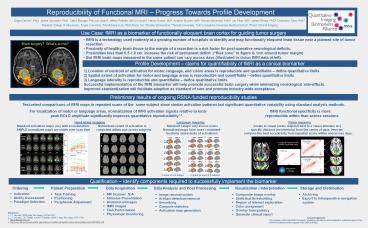Reproducibility of Functional MRI - PowerPoint PPT Presentation
Title:
Reproducibility of Functional MRI
Description:
Reproducibility of Functional MRI Progress Towards Profile Development Edgar DeYoe1, PhD, James Voyvodic2, PhD, Cathy Elsinger, PhD (co-chair)3, Jeffrey Petrella ... – PowerPoint PPT presentation
Number of Views:49
Avg rating:3.0/5.0
Title: Reproducibility of Functional MRI
1
Reproducibility of Functional MRI Progress
Towards Profile Development
Edgar DeYoe1, PhD, James Voyvodic2, PhD, Cathy
Elsinger, PhD (co-chair)3, Jeffrey Petrella, MD
(co-chair)2, Harris Ahmad, MD4, Andrew Buckler,
MS5, Feroze Mohamed, PhD6, Jay Pillai, MD7, James
Reuss, PhD8, Domenico Zaca, PhD7 1Medical
College of Wisconsin, 2Duke University,
3NordicNeuroLab, 4BioClinica, Inc, 5Buckler
Biomedical, 6Temple University, 7Johns Hopkins
University Medical School, 8Prism Clinical
Imaging
Use Case fMRI as a biomarker of functionally
eloquent brain cortex for guiding tumor surgery
- fMRI is a technology used routinely at a growing
number of hospitals to identify and map
functionally eloquent brain tissue near a planned
site of tumor resection. - Proximity of healthy brain tissue to the margin
of a resection is a risk factor for
post-operative neurological deficits. - Proximities less than 0.5-1.0 cm increase the
risk of permanent deficit. (Risk zone in figure
is 1cm around tumor margin) - But fMRI brain maps measured in the same patient
can vary across days (illustrated in vision fMRI
data at left).
Profile Development claims for quantifiability
of fMRI as a clinical biomarker
1) Location of centroid of activation for motor,
language, and vision areas is reproducible and
quantifiable define quantitative limits 2)
Spatial extent of activation for motor and
language areas is reproducible and quantifiable
define quantitative limits 3) Language laterality
is reproducible and quantifiable define
quantitative limits Successful implementation of
the fMRI biomarker will help promote successful
brain surgery while minimizing neurological
side-effects. Improved standardization will
facilitate adoption as standard of care and
promote industry-wide acceptance.
Preliminary results of ongoing RSNA-funded
reproducibility studies
Test-retest comparisons of fMRI maps
in repeated scans of the same subject show
similar activation patterns but significant
quantitative variability using standard analysis
methods. For localization of
motor or language areas, normalization of fMRI
activation signals relative to local
fMRI functional specificity is more
peak BOLD amplitude
significantly improves quantitative
reproducibility1,2.
reproducible within than across sessions
Hand motor
mapping
Language mapping
Vision mapping Standard activation
maps vary with scan duration Normalized
extent of activation is
Standard t-maps vary across scans
Voxels in visual cortex respond
best to a visual stimulus at a AMPLE
normalized maps are stable over scan time
consistent within and across subjects
Normalized maps have more consistent
specific distance
(eccentricity) from the center of gaze. Here we
locations and extents of activations
compare the best eccentricity
from repeated scans within and across days.
6 scans of one subject 2 scans for each
of 6 subjects
Qualification Identify components required to
successfully implement the biomarker
Ordering Patient Preparation
Data Acquisition
Data Analysis and Post Processing
Visualization / Interpretation
Storage and Distribution
- Indication
- Ability Assessment
- Paradigm Selection
- Task Training
- Positioning
- Peripherals Adjustment
- MR Scanner Q/A
- Stimulus Presentation
- Anatomical Images
- fMRI images
- Task Performance
- Physiologic monitoring
- Archiving
- Export to intraoperative navigation system
- Image reconstruction
- Artifact detection/removal
- Smoothing
- Compute statistics
- Activation map generation
- Composite image overlay
- Statistical thresholding
- Region of interest exploration
- Color assignment
- Overlay transparency
- Generate clinical report
References 1. J.T. Voyvodic (2006) Mag. Res.
Imag., 241249-1261. 2. J.T. Voyvodic, J.R.
Petrella, and A.H. Friedman (2009) J. Mag. Res.
Imag. 29751-759. 3. http//qibawiki.rsna.org 4.
http//www.fda.gov/downloads/Drugs/GuidanceComplia
nceRegulatoryInformation/Guidances/UCM230597.pdf
Acknowledgements The members of the QIBA fMRI
Technical Committee would like to acknowledge the
continued support of the RSNA and staff devoted
to support of the QIBA activities.































